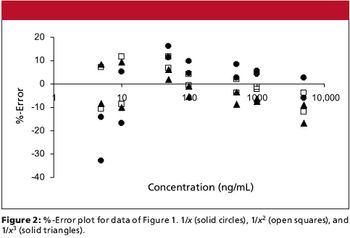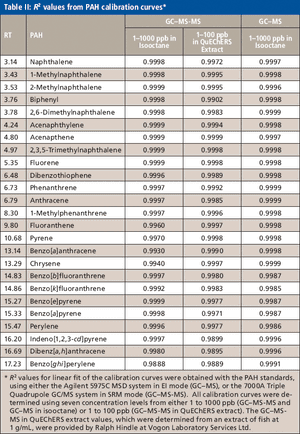Articles by Joan M. Stevens

A primary impediment to cannabinoid research is the fact that materials possessing psychoactive Δ-9-tetrathydrocannabinol are considered Schedule I drugs as defined in the U.S. Controlled Substances Act. An alternative source of cannabinoids may be found in hemp oil extracts. Hemp contains a low percentage of Δ-9-tetrathydrocannabinol (THC) by weight but relatively high amounts of non-psychoactive cannabinoids. The liquid chromatography-time of flight mass spectrometry (LC-TOF) method presented herein allows for the accurate, precise and robust speciation, profiling and quantification of cannabinoids in hemp oil extracts and commercial cannabinoid products for research and development laboratories. The method was determined to chromatographically separate 11 cannabinoids including differentiation of Δ-8-tetrahdrocannabinol and THC with excellent linear dynamic range, specificity and sensitivity.

A 12-minute analytical method was developed for 122 VDs in meat. The method uses Agilent All Ions MS/MS on a Q-TOF LC/MS instrument along with the Agilent Veterinary Drugs PCDL.

Determination of pharmaceuticals in biological matrices is commonly employed in ADME (DMPK), clinical, and forensic analysis. The main techniques used for drug monitoring and analysis are immunoassays, LC, and GC methods.

The threat to human health posed by the recent oil spill has created a pressing need for high-throughput seafood analysis to ensure that it does not contain dangerous levels of polycyclic aromatic hydrocarbons (PAHs) and to allow the earliest possible reopening of the fisheries. Adapting QuEChERS sample preparation technology to this application, combined with the use of preconfigured PAH gas chromatography–mass spectrometry analysis systems, can provide the ability to process in a timely manner the enormous number of samples that will be generated by the ongoing testing program.

The procedure involves a rapid and efficient pretreatment with SampliQ QuEChERS kits. The homogenized liver sample was initially extracted in a buffered aqueous/1% acetic acid acetonitrile system with an extraction and partitioning step after the addition of salts. Finally, the sample was cleaned up using dispersive solid-phase extraction (dispersive-SPE). The final extracts were analysed by the sensitive and selective determination of all compounds in a single run using LC–ESI-MS–MS operating in positive ion multiple reaction monitoring (MRM) mode. Sulphapyridine was selected as the internal standard. The accuracy of the method, expressed as recovery, was between 53 and 93%. The precision, expressed as RSD, was between 2.1 and 16.8%. The established 5 ng/g limits of quantification (LOQ) were much lower than the respective maximum residue limit (MRL) for sulphonamide in animal food products (20–100 ng/g).

The procedure involves a rapid and efficient pretreatment by SampliQ QuEChERS kits. The homogenized liver sample was initially extracted in a buffered aqueous, 5% formic acid acetonitrile system. An extraction and partitioning step was performed after the addition of salts. Clean-up was done using dispersive solid-phase extraction (dispersive-SPE). The final extracts allowed determination of all compounds in a single run using LC–ESI-MS–MS operating in positive ion multiple reaction monitoring (MRM) mode. Norfloxacin was selected as the internal standard. The accuracy of the method, expressed as recovery, was between 62 and 113%. The precision, expressed as RSD, was between 2.2 and 13.4%. The established limit of quantification (LOQ) was 5 ng/g and is significantly lower than the respective maximum residue limit (MRL) for quinolones in food producing animals.

The QuEChERS method for pesticide analysis was first introduced by USDA scientists in 2003. The EN method 15662:2007 is a European variation to the QuEChERS method. The method uses acetonitrile extraction, followed by the salting out of water from the sample using anhydrous magnesium sulphate (MgSO4, NaCl and buffering citrate salts to induce liquid–liquid partitioning.

The QuEChERS method for pesticide analysis was first introduced by USDA scientists in 2003.1 The EN method 15662:2007 is a European variation to the QuEChERS method.2,3

Based on the QuEChERS AOAC Official Method 2007.01, 16 pesticides were used for evaluating the performance of the Agilent's AOAC buffered extraction and SampliQ QuEChERS dispersive SPE kits for general fruits and vegetables.

Based on the QuEChERS AOAC Official Method 2007.01, sixteen pesticides were used for evaluating the performance of the Agilent's AOAC Buffered Extraction and SampliQ QuEChERS Dispersive SPE kits for General Fruits and Vegetables. Apple was selected as the fruit matrix. The pesticides are from the "representative pesticides" list (1). A method working well for these representative pesticides should work equally well for the other pesticides that are routinely monitored in multi-class, multi-residue methods. The compounds are from nine different pesticide classes: including acidic, basic, neutral, base-sensitive, and acid-labile pesticides. The selected pesticides are suitable for LC–MS-MS analysis. The MRLs of these pesticides have been set at 10 ng/g or higher (2–4).

Purification of synthetic, natural and biological compounds in any quantity usually requires the use of preparative HPLC.












